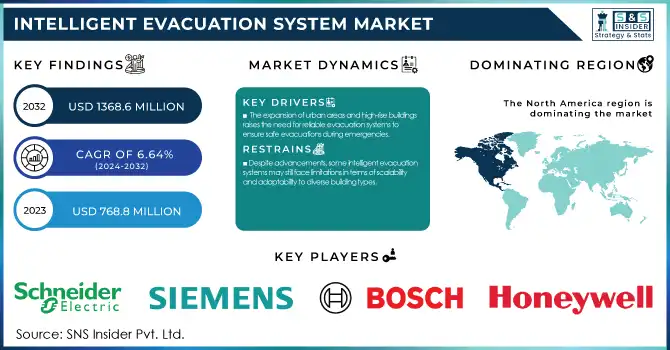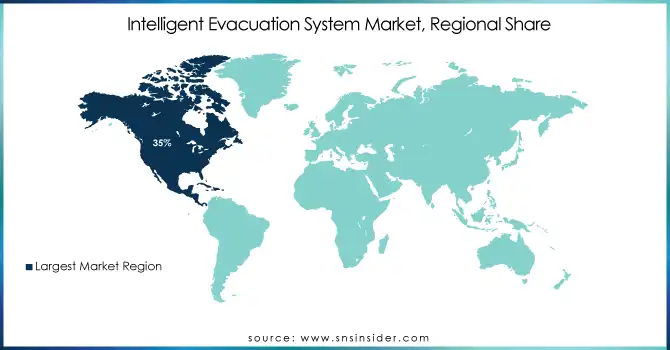Intelligent Evacuation System Market Report Scope & Overview:
The Intelligent Evacuation System Market was valued at USD 768.8 Million in 2023 and is expected to reach USD 1368.6 Million by 2032, growing at a CAGR of 6.64% from 2024-2032.

To get more information on Intelligent Evacuation System Market - Request Free Sample Report
The Intelligent Evacuation Systems market is experiencing rapid growth due to the increasing demand for enhanced safety and security in both commercial and residential sectors. These systems are designed to ensure the safe and efficient evacuation of individuals during emergencies such as fires, natural disasters, or other critical events. The market expansion is fueled by the need for advanced technologies that enable quick responses and better preparedness for emergencies. Notably, the integration of AI, IoT, and cloud-based solutions is transforming traditional evacuation systems into more intelligent, automated, and responsive solutions. Voice evacuation systems, which provide real-time emergency instructions, are being widely adopted in public spaces such as airports, shopping malls, and office buildings.
According to the National Fire Protection Association, nearly 3,000 fire-related deaths occur annually in the U.S., many of which could be prevented with proper emergency lighting to guide people to safety. As a result, stringent regulations are driving the adoption of emergency lighting systems that ensure visibility and safe exit routes during power outages or fires. This has contributed to the rapid growth of the emergency lighting segment within the Intelligent Evacuation System market. Additionally, the rise of smart buildings and an increased focus on safety measures are further accelerating market growth. With over 100,000 LEED-certified projects worldwide by 2023, the implementation of evacuation technologies in these buildings is becoming essential. The market is expected to continue its growth, driven by technological advancements, regulatory requirements, and the increasing adoption of smart technologies in both new and retrofitted buildings.
Intelligent Evacuation System Market Dynamics
Drivers
-
The expansion of urban areas and high-rise buildings raises the need for reliable evacuation systems to ensure safe evacuations during emergencies.
The increased urbanization and the proliferation of high-rise buildings have led to an increasing demand for effective and reliable evacuation systems. In a world where citizens are living in increasingly high-density cities and vertical residential units, maintaining the safety of the occupants in cases of emergencies such as fire, earthquake or other disasters is a growing challenge. Specifically, high-rise buildings pose specific challenges because of their height, large number of occupants, and several floors. Elders, disabled persons, and isolated individuals are often overlooked when it comes to evacuation and traditional means are inefficient in providing effective solutions to rapidly and safely evacuate every individual. Now, this is where smart evacuation systems become needed.
These leading systems use technologies such as AI, IoT, and real-time communication mechanisms to ensure emergency response through automation, for these situations. They direct occupants to the safest exit routes, control crowd movement, and provide essential information, such as emergency and location alerts. By way of example, voice evacuation systems provide instructions in real-time, while emergency lighting can improve visibility in case of a power loss.
To adapt to the evolving face of urbanization and the rise of high-rise buildings, safety regulations, and building codes are also tightening up and require the provision of such advanced evacuation systems. The increasing awareness of safety norms and the increasing population in high-rise buildings increase the demand for these systems. Thus, the Intelligent Evacuation System Market is gaining a lot of traction with the use of such systems being essential to protect the occupants base in an urban environment which is getting quite complex.
-
Increasing focus on public safety, especially in high-traffic areas like malls and airports, drives demand for efficient evacuation systems.
-
Integration of AI, IoT, and cloud-based solutions enhances the performance and responsiveness of evacuation systems, making them more intelligent and automated.
Restraints
-
Despite advancements, some intelligent evacuation systems may still face limitations in terms of scalability and adaptability to diverse building types.
While intelligent evacuation systems are indeed making significant strides, two aspects the market is struggling with are scalability and adaptability. With the development of such systems, they need to be designed to accommodate a range of building sizes, from small residential arrangements to large commercial buildings and high-rises. Not every building is the same; layout and structure differ, as do emergency needs, meaning there is no one-size-fits-all solution. A system designed for a tall building may not work as well in a low-rise or building with a more complicated layout, for example. Existing systems need to be scaled up, which also poses scalability issues. Upgrading the infrastructure of buildings for advanced evacuation technologies can be expensive and time-consuming. In addition, it may be difficult for intelligent evacuation systems to accommodate changes of use for a building or renovations since they will be expensive to update or costly to replace.
In addition, these systems rarely work in flawless unison with current safety equipment such as fire alarms sprinklers, and emergency exits. Moreover, the cost and complexity of implementation go up as there is a need for tailored solutions to focus on the requirements of individual buildings. Due to the rising demand for intelligent evacuation systems, this means manufacturers should focus on more flexible and scalable solutions that can be easily adapted to different classes of buildings. That should be key for large-scale uptake — especially in legacy buildings which might need pricey work to come up to safety standards of the modern era.
-
Integrating advanced evacuation systems with existing infrastructure can be difficult, requiring significant modifications and additional resources.
-
These systems require regular maintenance and updates, which can be resource-intensive and costly.
Intelligent Evacuation System Market Segment Analysis
By Type
The emergency lighting segment dominated the market and accounted for the largest revenue share of 41% in 2023. With cities undergoing expansion, along with a plethora of commercial and residential buildings springing up, the demand for emergency lighting is ever-increasing, coupled with modern safety systems. The inclusion of these systems has been made an integral part of a new construction project, which in turn is a key driver of the market growth.
The voice evacuation systems segment is anticipated to register the fastest CAGR from 2024 to 2032. The need for voice evacuation systems is increasing as it projects clear communication voice in complex areas. In larger buildings like airports, shopping malls, hospitals, and office complexes a traditional alarm is not enough to provide intricate instructions on where to evacuate. voice evacuation systems meet this need by broadcasting live or pre-recorded messages that direct an occupant to safety, providing critical information that helps minimize confusion and panic during an emergency.
By End-Use
The commercial segment dominated the market with the largest revenue share of 44.2% in 2023. The expansion of this market is due to the rising need for automation in industrial operations. Commercial properties are stepping up the consideration of safety and risk management, which in turn is expected to trigger the demand for smart evacuation systems. With businesses and property managers becoming more aware of risks and vulnerabilities, more comprehensive safety solutions are being implemented. Smart evacuation systems allow for crisis management to be much more effective and proactive in risk management
The residential segment is expected to grow at the fastest CAGR during the forecast period. The increase in multi-family and high-density residential housing drives the demand for smart evacuation systems. The complexity of evacuations in an emergency: apartments, condos, and high-rise buildings. In such environments, intelligent evacuation systems provide value in the form of coordinated emergency alerts and information on where multiple residents should evacuate safely.
Regional Analysis
In 2023, North America dominated the market and represented a revenue share of more than 35%. North America is one of the leading countries in the trend toward the use of smart building technologies, which mainly boost the growth of the market. There is also a trend in the region for smart technologies, integrating things such as lighting, security, and climate control in smart buildings. When combined with these smart technologies, intelligent evacuation systems perform better and offer desirable features for projects built in modern times.
The Europe sector intelligent evacuation system market is projected to experience a significant CAGR during the period 2024-2032. Market growth is also aided by the regions with strict regulatory standards for building safety. European nations now have much more stringent regulations and standards that require advanced building life safety systems, such as evacuation systems. As an example, the Construction Products Regulation of the European Union or various national building codes within the EU mandate that all commercial, public, and residential buildings have an effective fire safety and evacuation solution. This regulation strongly requires smart evacuation systems with high safety standards and compliance.

Get Customized Report as per Your Business Requirement - Enquiry Now
Key Players
The major key players along with their products are
-
Honeywell International – Voice Evacuation Systems
-
Bosch Security Systems – Emergency Lighting Systems
-
Siemens AG – Mass Notification Systems
-
Schneider Electric – Smart Emergency Lighting
-
Johnson Controls – Fire Alarm Systems
-
Mircom Group of Companies – Mass Notification Solutions
-
Eaton Corporation – Emergency Lighting
-
Kidde-Fenwal, Inc. – Fire Alarm and Detection Systems
-
Tait Communications – Emergency Communication Systems
-
UTC Climate, Controls & Security – Intelligent Evacuation Systems
-
Apollo Fire Detectors – Fire Detection and Alarm Systems
-
Edwards – Fire Alarm Systems
Recent development
-
January 2024: Honeywell launched an enhanced version of its voice evacuation system, integrating AI to provide real-time data analysis and emergency alerts, improving evacuation efficiency in large commercial buildings.
-
February 2024: Bosch introduced a new mass notification system designed to integrate seamlessly with existing building management systems, offering faster response times and improved occupant safety in high-rise buildings.
-
March 2024: Siemens unveiled a cloud-based emergency lighting solution for smart buildings, enabling real-time monitoring and control of lighting systems to ensure clear evacuation routes during emergencies.
|
Report Attributes |
Details |
|
Market Size in 2023 |
USD 768.8 Million |
|
Market Size by 2032 |
USD 1368.6 Million |
|
CAGR |
CAGR of 6.64% From 2024 to 2032 |
|
Base Year |
2023 |
|
Forecast Period |
2024-2032 |
|
Historical Data |
2020-2022 |
|
Report Scope & Coverage |
Market Size, Segments Analysis, Competitive Landscape, Regional Analysis, DROC & SWOT Analysis, Forecast Outlook |
|
Key Segments |
• By Type (Voice Evacuation Systems, Mass Notification Systems, Emergency Lighting, Others) |
|
Regional Analysis/Coverage |
North America (US, Canada, Mexico), Europe (Eastern Europe [Poland, Romania, Hungary, Turkey, Rest of Eastern Europe] Western Europe] Germany, France, UK, Italy, Spain, Netherlands, Switzerland, Austria, Rest of Western Europe]), Asia Pacific (China, India, Japan, South Korea, Vietnam, Singapore, Australia, Rest of Asia Pacific), Middle East & Africa (Middle East [UAE, Egypt, Saudi Arabia, Qatar, Rest of Middle East], Africa [Nigeria, South Africa, Rest of Africa], Latin America (Brazil, Argentina, Colombia, Rest of Latin America) |
|
Company Profiles |
Honeywell International, Bosch Security Systems, Siemens AG, Schneider Electric, Johnson Controls, Mircom Group of Companies, Eaton Corporation, Kidde-Fenwal, Inc., Tait Communications, UTC Climate, Controls & Security, Apollo Fire Detectors, Edwards |
|
Key Drivers |
• Increasing focus on public safety, especially in high-traffic areas like malls and airports, drives demand for efficient evacuation systems. |
|
RESTRAINTS |
• Integrating advanced evacuation systems with existing infrastructure can be difficult, requiring significant modifications and additional resources. |

